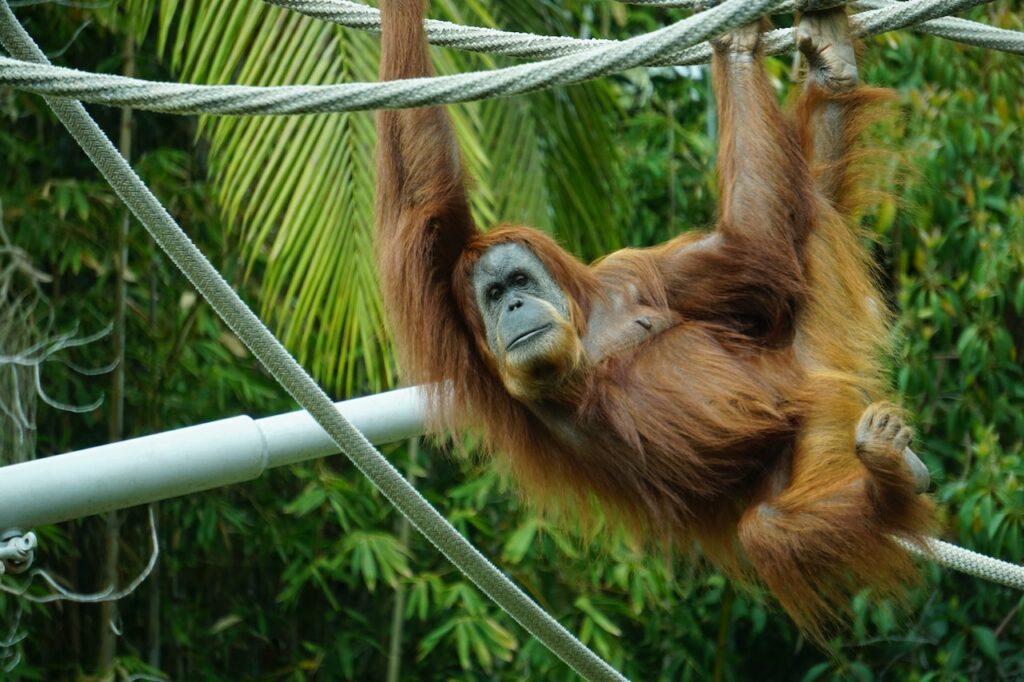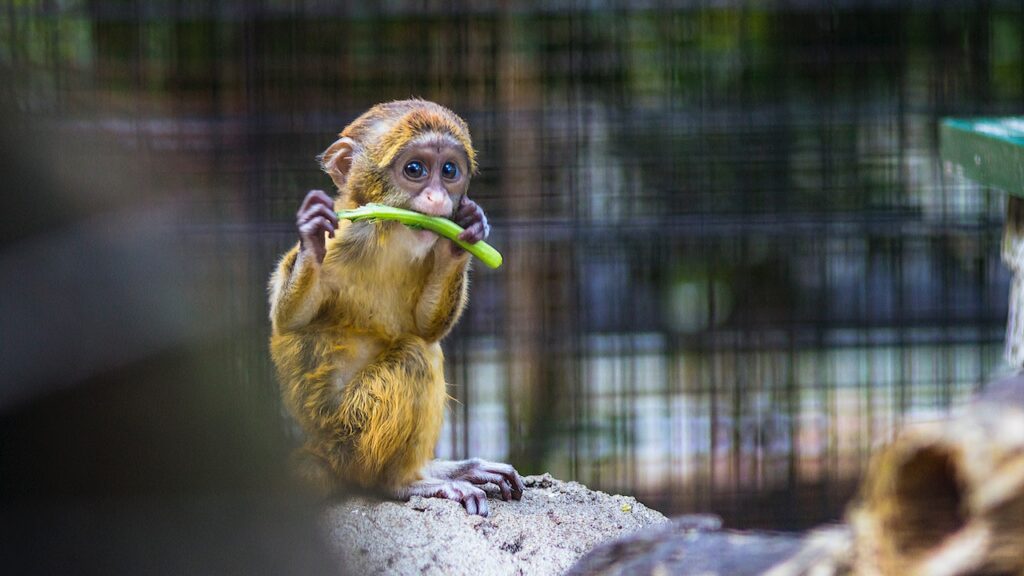Hawaii’s diverse wildlife and unique ecosystem often raise the question, “Are there monkeys in Hawaii?” While monkeys are not naturally found in the wild in Hawaii, the islands offer a rich variety of other fascinating creatures to discover. Let’s delve into Hawaii’s tropical wildlife and explore the wonders that await!
Key Takeaways:
- Hawaii does not have monkeys in its wild, native species.
- The monk seal and hoary bat are the only mammal species native to Hawaii.
- Hawaii’s isolation in the middle of the ocean makes it challenging for monkeys to reach the islands naturally.
- Visitors can see monkeys at the Honolulu Zoo.
- Hawaii is home to unique species such as the Hawaiian monk seal, humpback whales, Hawaiian green sea turtles, Nene geese, and more.
- Preserving Hawaii’s delicate ecosystems and biodiversity is crucial for responsible travel.
The Wildlife of Hawaii: An Overview
Hawaii boasts a remarkable array of wildlife, but you won’t find any monkeys among its unique fauna. The isolated location of the islands in the middle of the ocean has made it challenging for monkeys to naturally reach Hawaii. However, this doesn’t mean that Hawaii lacks biodiversity. The islands are home to a fascinating range of native species, including the Hawaiian monk seal and the hoary bat.
The Hawaiian monk seal, known for its adorable appearance and gentle nature, is one of the few species of seals found in warm tropical waters. The hoary bat, on the other hand, is the only native land mammal in Hawaii. These nocturnal creatures are excellent aerial hunters, often spotted flying over the islands at dusk.
To catch a glimpse of monkeys in Hawaii, one would need to visit the Honolulu Zoo. This controlled environment provides a home to various monkey species, allowing visitors to observe and learn about these captivating creatures up close. The zoo plays an essential role in both preservation and education, contributing to the conservation efforts of these animals.
| Notable Native Wildlife of Hawaii | |
|---|---|
| Hawaiian Monk Seal | Endemic to the Hawaiian Islands, this critically endangered species is known for its playful nature and distinctive appearance. |
| Humpback Whales | Every year, humpback whales migrate to the warm Hawaiian waters from Alaska, making the islands a prime spot for whale-watching. |
| Hawaiian Green Sea Turtles | These ancient reptiles are an iconic symbol of Hawaii’s marine life and can often be seen basking on the shores or swimming in the crystal-clear waters. |
| Nene Geese | The Nene geese are the state bird of Hawaii and are endemic to the islands. They are known for their distinctive call and adaptability to the island’s unique environment. |
Preserving Hawaii’s delicate ecosystems is crucial to maintaining the rich biodiversity found on the islands. As responsible travelers, it is important to be mindful of our impact on the environment and support initiatives that protect and conserve Hawaii’s native wildlife. By embracing the diverse array of species that call Hawaii home, we can play a role in safeguarding the natural wonders of this magnificent archipelago.
The Honolulu Zoo: Where to Spot Monkeys in Hawaii

While monkeys are not part of Hawaii’s native wildlife, visitors can still catch a glimpse of these playful creatures at the Honolulu Zoo. This beloved attraction is home to a variety of monkey species, providing a unique opportunity to observe and learn about these fascinating animals up close.
The Honolulu Zoo houses several monkey species, each with its own distinct characteristics and behaviors. From the mischievous capuchin monkeys to the vibrant colobus monkeys, there is something for everyone to admire. Visitors can witness the agile movements and curious nature of these primates as they interact with their environment and each other.
As part of its conservation efforts, the zoo plays an important role in preserving these monkey species and raising awareness about their conservation needs. Through educational programs and exhibits, visitors can gain a deeper understanding of the challenges facing monkeys in the wild and what can be done to protect them.
| Monkey Species | Native Range | Characteristics |
|---|---|---|
| Capuchin Monkey | Central and South America | Intelligent, dexterous, and known for their tool-using abilities. |
| Colobus Monkey | Africa | Characterized by their striking black-and-white fur and arboreal lifestyle. |
| Squirrel Monkey | Central and South America | Energetic and social, with a wide range of vocalizations. |
So, if you’re eager to spot monkeys in Hawaii, the Honolulu Zoo is the place to be. Not only will you have the chance to see these lively animals in action, but you’ll also be supporting important conservation efforts. Remember to visit responsibly and take advantage of the zoo’s educational resources to gain a deeper appreciation for the diverse wildlife found in Hawaii and beyond.
Hawaii’s Native Wildlife Treasures
Although monkeys are not native to Hawaii, the islands are home to an abundance of other captivating wildlife species. From the majestic Hawaiian monk seal to the enchanting humpback whales, Hawaii’s unique ecosystem offers a plethora of native fauna that is worth exploring and cherishing. One of the most iconic creatures found in Hawaii is the Hawaiian green sea turtle, known locally as the Honu. These graceful marine reptiles can often be spotted swimming in the crystal-clear waters or basking in the sun on the sandy shores of the Hawaiian beaches.
Another fascinating species that calls Hawaii home is the Nene goose. This endangered bird is the state bird of Hawaii and can be found in various parts of the islands. With its distinctive appearance and honking call, the Nene goose is a cherished symbol of Hawaiian wildlife conservation efforts. Visitors to Hawaii may also have the opportunity to catch a glimpse of the charismatic hoary bat, a small mammal native to the islands. These nocturnal creatures are known for their incredible agility and impressive hunting skills.
| Native Wildlife Species | Description |
|---|---|
| Hawaiian Monk Seal | An endangered marine mammal endemic to Hawaii, known for its playful nature and beachside lounging. |
| Humpback Whales | These majestic creatures visit Hawaii’s warm waters during the winter months, offering a breathtaking sight for whale-watching enthusiasts. |
| Hawaiian Green Sea Turtles | Also called Honu, these ancient reptiles can often be seen gracefully swimming or basking on the sandy beaches. |
| Nene Geese | The official state bird of Hawaii, this endemic species symbolizes the state’s commitment to protecting its unique wildlife. |
| Hoary Bat | A small mammal known for its distinct appearance and remarkable hunting abilities. |
Exploring the native wildlife treasures of Hawaii is not only a memorable experience but also an opportunity to learn about the delicate balance of the island’s ecosystems. It is essential to protect these species and their habitats to ensure their survival for future generations. By being responsible travelers and supporting conservation efforts, visitors can contribute to preserving Hawaii’s diverse wildlife and ensuring the sustainability of its unique ecosystem.
Preserving Hawaii’s Delicate Ecosystems

To ensure the longevity of Hawaii’s diverse flora and fauna, it is crucial for visitors to be responsible and actively participate in preserving the islands’ delicate ecosystems. With its unique wildlife and fragile ecosystems, Hawaii’s natural wonders are a treasure worth protecting. By following sustainable practices and supporting conservation initiatives, we can help maintain the beauty and biodiversity of the Hawaiian islands.
Responsible travel begins with respecting the native wildlife and their habitats. Avoid disturbing or feeding wild animals, as this can disrupt natural behaviors and harm their health. Take care to dispose of trash properly and refrain from littering, as marine debris poses a significant threat to Hawaii’s marine life. Participating in beach clean-ups and supporting local organizations dedicated to environmental conservation are great ways to contribute to the preservation of Hawaii’s wildlife.
Another important aspect of preserving Hawaii’s delicate ecosystems is supporting sustainable tourism. Choose eco-friendly accommodations that prioritize environmental conservation and minimize their carbon footprint. Use reef-safe sunscreen to protect Hawaii’s coral reefs from harmful chemicals. Opt for nature-based activities that have minimal impact on the environment, such as hiking, snorkeling, or bird-watching. By choosing sustainable options, we can enjoy the beauty of Hawaii while minimizing our ecological footprint.
Hawaii’s Wildlife Conservation Organizations
| Name | Mission | Website |
|---|---|---|
| Hawaii Wildlife Fund | Dedicated to the conservation of Hawaii’s native wildlife through research, education, and community involvement. | www.hawaiiwildlifefund.org |
| The Nature Conservancy Hawaii | Works to preserve the unique ecosystems of Hawaii through land and water protection, restoration projects, and community engagement. | www.nature.org/hawaii |
| Hawaii Marine Animal Response | Focuses on the rescue, rehabilitation, and conservation of Hawaii’s marine mammals and sea turtles. | www.hmari.org |
Exploring Hawaii’s Ecological Isolation
Hawaii’s remote location in the middle of the Pacific Ocean has created a unique ecological isolation, making it nearly impossible for monkeys to establish natural populations on the islands. The isolation, combined with the absence of suitable habitats, has prevented monkeys from colonizing Hawaii’s ecosystems. With no land connections to other continents or nearby islands, Hawaii’s geographic isolation has shaped its distinct wildlife composition.
The Hawaiian archipelago is home to a variety of endemic species, including the monk seal and the hoary bat. These native mammals have adapted to the island’s unique environment over thousands of years. However, monkeys, which are not native to Hawaii, have no natural habitats and face significant challenges in reaching the islands.
While monkeys may not roam freely in Hawaii’s wild, visitors can still encounter them at the Honolulu Zoo. The zoo provides a controlled environment where different monkey species can be observed and studied. It plays an essential role in preserving and showcasing these fascinating animals, contributing to education and conservation efforts.
Preserving Hawaii’s Delicate Ecosystems
Hawaii’s delicate ecosystems are home to a diverse range of wildlife, both native and introduced species. It is important for visitors and residents alike to be responsible travelers and support initiatives that protect and conserve the island’s biodiversity. By being mindful of our impact on the environment, we can help preserve the natural beauty and unique wildlife found in Hawaii.
By appreciating and respecting Hawaii’s wildlife diversity, we can contribute to the ongoing efforts to protect and conserve the islands’ delicate ecosystems. Whether it’s the native Hawaiian monk seal, the majestic humpback whales, or the endangered Nene geese, each species contributes to the intricate balance of Hawaii’s natural environment. Let us embrace the wonder and beauty of Hawaii’s wildlife and work together to ensure its preservation for future generations.
| Hawaii’s Native Wildlife Treasures |
|---|
| Hawaiian monk seal |
| Humpback whales |
| Hawaiian green sea turtles |
| Nene geese |
Hawaii’s Fascinating Endemic Species
Hawaii is renowned for its fascinating endemic species, including several primate species found nowhere else in the world. While monkeys are not part of Hawaii’s native fauna, there are a variety of unique and captivating animals that call the islands home. From the iconic Hawaiian monk seal to the majestic humpback whales and the graceful Hawaiian green sea turtles, Hawaii’s wildlife offers a rich tapestry of biodiversity.
One of Hawaii’s most notable endemic species is the Nene goose, the state bird and a symbol of conservation success. This goose, once on the brink of extinction, has made a remarkable recovery through dedicated conservation efforts. Other endemic birds, such as the Apapane and the I’iwi, paint the skies with their vibrant colors and enchanting melodies.
In addition to avian wonders, Hawaii is home to unique primate species that can only be found in the islands. The Hawaiian spider monkey and the Hawaiian marmoset are two primate species that have adapted to the unique ecosystems of Hawaii. These primates have evolved in isolation, developing distinct characteristics and behaviors that make them truly exceptional.
| Endemic Species | Description |
|---|---|
| Hawaiian Monk Seal | An endangered species, the Hawaiian monk seal is one of the rarest marine mammals in the world. It can often be spotted basking in the sun on the sandy shores of Hawaii’s beaches. |
| Nene Goose | The Nene goose is endemic to Hawaii and has made a remarkable recovery from near extinction. It is a symbol of conservation success and can be found in various habitats across the islands. |
| Hawaiian Spider Monkey | The Hawaiian spider monkey is a unique primate species found only in Hawaii. With its long limbs and agile movements, it has adapted to the island’s diverse forest ecosystems. |
| Hawaiian Marmoset | The Hawaiian marmoset is another primate species exclusive to Hawaii. It has a distinct appearance and behavior, showcasing the incredible diversity of primates within the islands. |
Exploring Hawaii’s endemic species offers a chance to witness the wonders of evolution and the delicate balance of ecosystems. As visitors, it is important to be responsible travelers, respecting and protecting the unique wildlife of Hawaii. By supporting conservation initiatives and practicing sustainable tourism, we can ensure that future generations continue to marvel at the beauty and diversity of Hawaii’s endemic species.
Conclusion: Embracing Hawaii’s Wildlife Diversity
While monkeys may be absent from Hawaii’s wild, the islands offer an abundance of other captivating wildlife species, making it a paradise for nature enthusiasts. Hawaii’s unique geographical location and isolation in the middle of the ocean have resulted in a diverse array of native flora and fauna that are found nowhere else on Earth.
The Hawaiian islands are home to incredible creatures such as the Hawaiian monk seal, a critically endangered species that can be spotted basking on the sandy shores. The iconic humpback whales also migrate to Hawaii’s warm waters during the winter months, captivating onlookers with their majestic displays.
The Hawaiian green sea turtles, known as honu, gracefully glide through the crystal-clear waters, while the elusive Nene geese, Hawaii’s state bird, can be spotted in the lush mountainous regions. These endemic species are part of the delicate ecosystem that makes Hawaii such a unique and precious place.
As responsible travelers, it is crucial that we cherish and protect Hawaii’s wildlife diversity. By supporting conservation efforts and practicing sustainable tourism, we can ensure the preservation of this fragile ecosystem for generations to come. Let us continue to embrace the wonders of Hawaii’s wildlife and play our part in safeguarding its future.
FAQ
Are there monkeys in Hawaii?
No, there are no monkeys in Hawaii in the wild. The isolated location of the islands makes it difficult for monkeys to naturally reach Hawaii.
Where can I see monkeys in Hawaii?
You can see monkeys at the Honolulu Zoo, where they are kept in a controlled environment for visitors to observe and learn about.
What native wildlife species can be found in Hawaii?
Hawaii is home to native species like the monk seal, hoary bat, humpback whales, Hawaiian green sea turtles, Nene geese, and many more.
Why is it important to protect Hawaii’s ecosystems?
Protecting Hawaii’s delicate ecosystems is crucial to preserving its biodiversity and unique wildlife. Responsible travel and conservation efforts are necessary to maintain the island’s natural balance.
Why aren’t there monkeys in the wild in Hawaii?
Hawaii’s isolation and lack of suitable habitats make it challenging for monkeys to colonize the islands naturally.
What are some of Hawaii’s endemic species?
Hawaii’s endemic species include a wide range of animals and plants that are found exclusively in the Hawaiian islands. Some examples are the Hawaiian monk seal, Nene geese, and various plant species.
In conclusion, should I expect to see monkeys in Hawaii?
No, monkeys are not part of the native wildlife in Hawaii. However, there are many other unique and fascinating species to explore and appreciate in the islands’ diverse ecosystem.

Scott Sweeney is the creator of Virtual Hawaii 360. Scott is a professional marketer and a lifelong Hawaii enthusiast. Scott splits time between Oahu and Dayton, Ohio. In addition to his marketing endevours, he is also a published Ukulele musician.
